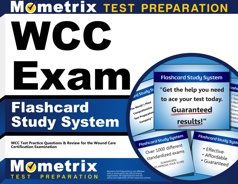Caring for wounds is a serious business. That’s one of the reasons the National Alliance of Wound Care and Ostomy offers the Wound Care Certification Examination. Professionals who achieve this certification show that they have mastered skills in skin and wound care management. These heath care specialists provide care in all care setting, whether it be hands-on or consultative. Here’s what candidates need to know about the test.
Online Wound Care Certification Prep Course
If you want to be fully prepared, Mometrix offers an online WCC Prep Course. The course is designed to provide you with any and every resource you might want while studying. The WCC Course includes:
- Review Lessons Covering Every Topic
- 550 WCC Practice Questions
- More than 300 Digital Flashcards
- Money-back Guarantee
- Free Mobile Access
- and More!
The WCC Prep Course is designed to help any learner get everything they need to prepare for their Wound Care Certification exam. Click below to check it out!
Where can I take the Wound Care Certification Examiniation?
Computerized versions of the examination are administered at a third-party testing center, which has offices throughout the United States. Paper and pencil tests are available via proctor for students taking classes through the Education Pathway.
How long does the credential last?
The credential lasts for five years, at which point candidates can be recertified.
What are the exam fees?
The initial certificaton, recertification and retest fees are $300 each.
How many questions are on the Wound Care Certification Examiniation?
There are 110 questrions on the test, which can be taken via computer or pencil and paper. Of the 110 questions, 10 are not scored.
How much time do I have to complete the test?
Candidates have two hours to complete the exam.
What’s on the Wound Care Certification Examination?
The test contains eight categories. Three of the categories — patient assessment, data collection & analysis, wound etiology & description, and treatment administration & management — account for 60 percent of the test questions.
- Structures & functions of normal skin accounts for five percent of the test and includes Identifying and describing normal skin characteristics.
- Identification & management of risk factors impacting skin integrity examines the intrinsic and extrinsic influences on skin. This portion accounts for 10 percent of the test questions.
- Wound healing process accounts for 15 percent of the exam. Candidates will be assessed on identifing methods of wound closure and intrinsic and extrinsic factors on the wound healing process.
- Patient assessment, data collection & analysis is 20 percent of the test. Candidates will answer questions about patient history, lab studies, non-laboratory diagnostics, interpreting risk assessment and healing assessment tools and more.
- Wound etiology & description is also 20 percent of the test. This section includes identifying wound types and wound classifications.
- Treatment administration & management assesses knowledge of wound cleansers, dressings, wound bed preparation and more. This section accounts for 20 percent of the test as well.
- Education & training accounts for five percent of the exam. This section focuses on the needs of the patient and family.
- Legal, ethics & policy focuses on the legal and ethical aspects of wound care and accounts for five percent of the test.
What are the test center policies?
There are several, and these are among them:
- Late-arriving candidates will not be allowed to take the test.
- No visitors are allowed in the testing center.
- Candidates may not bring coats, book bags, etc. into the testing room.
- Candidates must show a valid government-issused picture identification. The name on the identification must exactly match the name on the test authorization.
- Candidates are allowed to wear a watch during testing.
- Mobile phones must be turned off and placed under or away from your desk in the testing room.
How will I know if I passed the test?
The test is scored “pass/fail.” Candidates will receive the test results at the conclusion of the exam.
What if I fail the test?
Candidates who fail the exam will receive an email notification from the National Alliance of Wound Care and Ostomy with instructions on how to retake the test.
This sounds like a tough but important test. What are the best study materials I can get?
That’s easy. Mometrix offers study tools that will prepare you for the Wound Care Certification Examination. Our study guide includes practice test questions, test-taking tips, a study plan, and more. Our flashcards make an excellent companion to our study guide. Take the cards witih you anywhere you go, and when you have a minute, review your practice questions. These are two tools you don’t want to be without.






